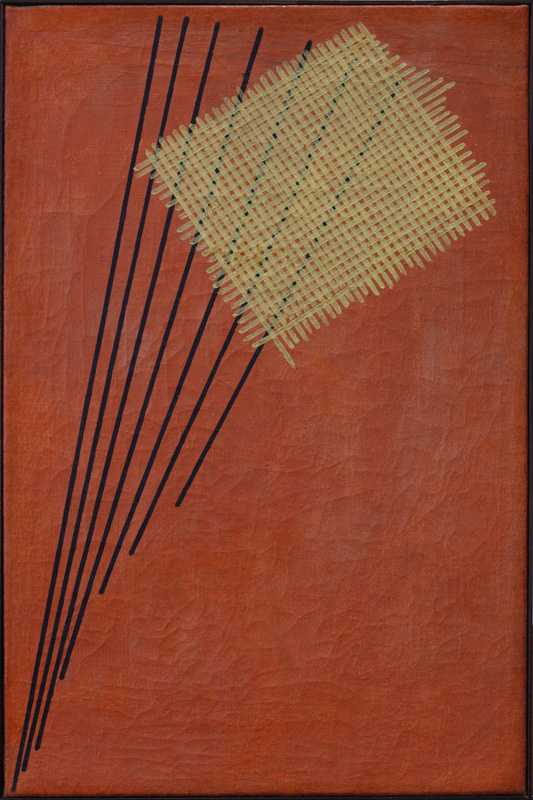THE RAY OF DISPLACEMENT (4)
By:
January 28, 2024

Construction no. 95 (1919)
Harriet Prescott Spofford’s “The Ray of Displacement” — which makes the shocking suggestion, at one point, that Jesus may have been a dimension-hopping scientist — was first published October 1903 in The Metropolitan Magazine, with illustrations by Lester Ralph. It has appeared in proto-sf collections edited by Sam Moskowitz, Mike Ashley, and others. HiLoBooks is pleased to serialize it here for HILOBROW’s readers.
ALL INSTALLMENTS: 1 | 2 | 3 | 4 | 5 | 6 | 7 | 8.
“If by yourself you could breathe breath into any pinch of feathers and toss it off your hand a creature — but, as it is, life is a trust. And you, a man of parts, of power, hold it only to return with usury.”
“And stripped of the power of gathering usury! Robbed of the work about to revolutionize the world!”
“The world moves on wide waves. Another man will presently have reached your discovery.”
As if that were a thing to be glad of! I learned afterwards that St. Angel had given up the sweetness of life for the sake of his enemy. He had gone to prison, and himself worn the stripes, rather than the woman he loved should know her husband was the criminal. Perhaps he did not reconcile this with his love of inviolate truth. But St. Angel had never felt so much regard for his own soul as for the service of others. Self-forgetfulness was the dominant of all his nature.
“Tell me,” he said, sitting with me, “about your work.”
A whim of trustfulness seized me. I drew an outline, but paused at the look of pity on his face. He felt there was but one conclusion to draw — that I was a madman.
“Very well,” I said, “you shall see.” And I walked through the wall before his amazed eyes, and walked back again.
For a moment speechless, “You have hypnotic power,” then he said. “You made me think I saw it.”
“You did see it. I can go free any day I choose.”
“And you do not?”
“I must be vindicated.” And I told exactly what had taken place with Brant and his diamond. “Perhaps that vindication will never come,” I said at last. “The offended amour propre, and the hope of gain, hindered in the beginning. Now he will find it impossible.”
“That is too monstrous to believe!” said St. Angel. “But since you can, why not spend an hour or two at night with your work?”
“In these clothes! How long before I should be brought back? The first wayfarer — oh, you see!”
St. Angel thought a while. “You are my size,” he said then. “We will exchange clothes. I will remain here. In three hours return, that you may get your sleep. It is fortunate the prison should be in the same town.”
Night after night then I was in my old rooms, the shutters up, lost in my dreams and my researches, arriving at great ends.
Night after night I reappeared on the moment, and St. Angel went his way.
I had now found that molecular displacement can be had in various directions. Going further, I saw that gravity acts on bodies whose molecules are on the same plane, and one of the possible results of the application of the Y-ray was the suspension of the laws of gravity. This possibly accounted for an almost inappreciable buoyancy and the power of directing one’s course. My last studies showed that a substance thus treated has the degenerative power of attracting the molecules of any norm into its new orbit — a disastrous possibility. A chair might disappear into a table previously treated by a Y-ray. In fact, the outlook was to infinity. The change so slight — the result so astonishing! The subject might go into molecular interstices as far removed, to all essential purpose, as if billions of miles away in interstellar space. Nothing was changed, nothing disrupted; but the thing had stepped aside to let the world go by. The secrets of the world were mine. The criminal was at my mercy. The lover had no reserves from me. And as for my enemy, the Lord had delivered him into my hand. I could leave him only a puzzle for the dissectors. I could make him, although yet alive, a conscious ghost to stand or wander in his altered shape through years of nightmare alone and lost. What wonders of energy would follow this ray of displacement. What withdrawal of malignant growth and deteriorating tissue was to come. “To what heights of succor for humanity the surgeon can rise with it!” said St. Angel, as, full of my enthusiasm, I dilated on the marvel.
“He can work miracles!” I exclaimed. “He can heal the sick, walk on the deep, perhaps — who knows — raise the dead!”
RADIUM AGE PROTO-SF: “Radium Age” is Josh Glenn’s name for the nascent sf genre’s c. 1900–1935 era, a period which saw the discovery of radioactivity, i.e., the revelation that matter itself is constantly in movement — a fitting metaphor for the first decades of the 20th century, during which old scientific, religious, political, and social certainties were shattered. More info here.
SERIALIZED BY HILOBOOKS: James Parker’s Cocky the Fox | Annalee Newitz’s “The Great Oxygen Race” | Matthew Battles’s “Imago” | & many more original and reissued novels and stories.
